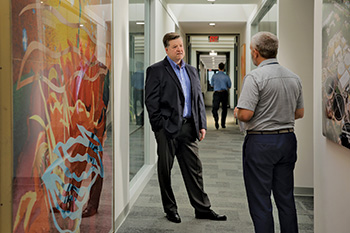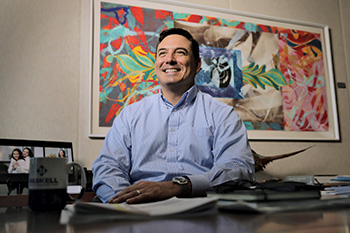Bolstered by a series of strategic acquisitions broadening its array of in-house capabilities, along with a major investment in modular construction, long-time design-builder Haskell is now embracing an all-of-the-above project delivery approach as it pursues a plan to nearly double annual revenue by 2025.
Such a leap would be impressive even during ordinary times. The Jacksonville, Fla.-based firm reported 2019 revenue of nearly $1.1 billion from construction and $91.2 million from design work, according to data submitted to ENR’s 2020 Top 400 survey. Achieving such growth while navigating a construction economy that’s still being buffeted by massive pandemic-induced uncertainty would be an enviable achievement. For now, at least, the company maintains that its five-year plan, announced before the coronavirus pandemic struck, remains unchanged.

Despite the current situation, CEO Jim O’Leary and team seem intent on finding out what’s possible. Picked as successor to long-time CEO Steve Halverson after a three-year selection process, O’Leary—who has worked for Haskell for more than 30 years—was announced as the firm’s president and chief executive officer in 2018.
By fall of that year, O’Leary was unveiling his plan, which places Haskell’s revenue goal toward the bottom of a list of six initiatives. The audaciously idealistic goal to “provide team members with the best job of their lives” takes the top spot.
That people-first focus carries over the long-time leadership of company founder Preston Haskell, who tells ENR that he repeatedly emphasized “recruitment, retention and development” of employees.
According to the company, which is privately owned, Haskell’s ownership structure “currently rests with the management team and an [employee stock ownership plan] that was established in 2008. All full-time employees are shareholders as part of their inclusion in the ESOP.” It remains common for Haskell employees to have been hired “straight out of school,” adds John-Paul “J.P.” Saenz, chief operating officer, O’Leary’s former position.
Halverson, who is currently chairman of the board, says it was O’Leary’s commitment to Haskell’s existing culture that was “the real reason” he got the job. “I believed and the board believed that Jim would be the most protective custodian of company culture and values—the most important thing a CEO does,” Halverson says.
Still, O’Leary sought a reboot. “It was important to hit the reset button and establish what we want Haskell to look like in 2025—to make it aspirational and something that people can connect to,” he says.
The goals include “driving operational excellence,” diversifying the business, strengthening the firm’s engineering and design expertise, and expanding diversity, among others. O’Leary speaks passionately about his belief that if the company delivers on the separate goals of his 2025 plan, employees can find great satisfaction via a meaningful career at Haskell—like he has.
The company’s staff understands that O’Leary’s commitment to this goal is “genuine in every respect,” says Dave Balz, vice president of workforce development. “He deeply believes Haskell should provide team members with the best job of their lives,” Balz says. “This is well understood and consistently reinforced across all levels of the business.”
|
Related Article |
Expanded Delivery
在过去的十年中,哈斯克尔(Haskell)执行了战略收购,以大约每两年扩大一次能力。同时,长期设计构建器逐渐开始使用过去通常不选择的其他项目交付方法,例如施工管理 - 风险。
Haskell持续扩展的服务和能力及其更多样化的项目交付方法尚不为所有竞争对手所熟知。一位与另一位东南承包商的高管告诉ENR:“我的印象是Haskell可能会少关心必须进行设计”,并且选择了更广泛的新利18备用项目交付方法。
“It was important to hit the reset button and establish … what we want Haskell to look like in 2025.”
- Haskell首席执行官Jim O’Leary
The expansion of its in-house expertise started in 2010, with the purchase of E2米,亚特兰大integrati制造系统on firm that was absorbed into the company. Since then, the acquisitions have remained independent while still functioning as part of Haskell. In 2012, Haskell acquired Seiberling, adding expertise in process engineering, technical consulting and automation for food and beverage and biopharma projects. A 2014 acquisition of Freeman White and Catalyst added health care design and consulting experience. And the 2016 acquisition of Benham added expertise on engineering-procurement-construction (EPC) project delivery in the food and beverage and consumer products sectors.
Additionally, in May 2019, Haskell made a strategic investment—of an undisclosed amount—in BLOX, a Bessemer, Ala.-based prefabrication specialist with roughly 400 employees that describes its methodology as “design-manufacture-construct.”
A main focus of Haskell’s growth strategy, though, falls upon its industrial projects, specifically its largest market, food and beverage. The contractor, which ranked seventh among ENR’s 2020 Top 400 ranking of industrial contractors, reported approximately $557.2 million in 2019 construction and design revenue from industrial processing projects. Of that total, domestic projects generated $515.87 million in revenue, while international jobs provided the remaining $46.7 million.
Here, too, Haskell believes that its expanded roster of skill sets, most particularly its expertise in process engineering and EPC project delivery, will boost its bottom line. Attaining this goal has been a focus since 2008, when Haskell first eyed acquisition as a means to capture more of the capital expenditure of food and beverage project owners, says COO Saenz.
“In most of these situations, that [process engineering] portion of the work was usually two times the contract volume of the work we were performing,” says Saenz. “There was this great opportunity sitting out there.” In-house expertise “quickly changed our food and beverage business,” he adds.
A recent contract to deliver a can line—capable of producing 1200 cans per minute—for LiDestri Food and Drink offers an example of the potential opportunity for Haskell. Stefani LiDestri, CEO of LiDestri Food and Drink, says Haskell’s “diverse knowledge and resources” aided her firm’s selection of a contractor. Specifically, Haskell’s “ability to field manage under the direction of their own in-house engineering … allowed us to move forward with equipment purchases in a timely manner with the full confidence that they would be able to coordinate the design and installation.”
Stand-Alone Services
当它获得Benham及其EPC交付经验时,Haskell已经看到了“独立提供服务的机会并不总是整合所有服务,” Saenz说。“对于某些客户来说,这就是他们如何采购服务的本质。他们中的一些人不会购买所有捆绑成设计或EPC合同的服务。”

Photo by Bob Self for ENR
Saenz adds that the four divisions that Haskell acquired continue to develop their own client relationships, which have “many times” evolved into integrated delivery contracts in the future.
Internally, Haskell’s food-and-beverage projects fall under its consumer and package goods (CPG) division, which covers “pretty much everything you can buy at a Walmart,” says Michael Woods, who leads the group. The ability to deliver process engineering for packaging, automation and both wet and dry processes has brought new opportunities.
“By having that differentiation, we’ve been able to expand from lump-sum contracts to services-only contracts, construction-management contracts,
design-build contracts or EPC,” Woods says. “We grow the business by not saying no.”
伍兹说,尽管经常被评为食品和饮料领域的顶级承包商之一(在Enr最近出版的排名中排名第二),但仍有相当大的增长空间。新利18备用根据该公司对食品和饮料设施的全球年度资本支出的估计,“我们仍然是市场份额的单位较低的百分比,”他说。“这告诉我们那里有很多机会。”
As is the case with other construction markets, the global coronavirus pandemic is causing uncertainty in this sector, too, as owners pause to reconsider their capital expenditure plans. “From a global perspective, we think that the addressable market is much much larger than our capacity to serve,” Woods says. “We look at it as continued untapped opportunity.”

Photo by Bob Self for ENR
推进技术
Another of O’Leary’s goals was to “Optimize intellectual capital, technology and innovation.” Since he became CEO, the contractor has taken tangible steps in that direction. Haskell was one of four founding members—along with Black & Veatch, DPR Construction and McCarthy Building Cos.—of the NEXT Coalition, announced in May, that is seeking “to identify and advance processes and technologies most likely to bolster construction safety in response to the ‘next normal’ ushered in by COVID-19.” In a statement announcing NEXT, O’Leary says the aim of the group is “to accelerate impactful change within our industry and beyond.”
但Haskell已经在technology arena. In June 2018, the contractor created a separate venture, Dysruptek, to support the company’s technology and innovation goal. The group focuses on finding, developing and, critically, investing in new technology and delivery methods, says Cutler Knupp, who leads Dysruptek with the title of director of strategy and investment.To that end, Dysruptek invested in industry capital investment firm Brick & Mortar Ventures as a strategic limited partner. In turn, Brick & Mortar provides Dysruptek with access to emerging technology companies so it can pilot those technologies on Haskell projects.
Dysruptek scouts for tools and delivery methods that could prove impactful anywhere from two to 10 years in the future, says Knupp, who has a background in finance and corporate strategy.
Dysruptek was instrumental in Haskell’s 2019 strategic investment in BLOX, the Alabama-based company offering the design-manufacture-construct delivery method (see related story p. 24).
Pushing the bounds of technology produced a positive result on the construction of a new Miami cruise terminal for Norwegian Cruise Lines, working in a joint venture with Miami-based contractor NV2A Group. The terminal’s curvilinear design, by Miami architect Bermello Ajamil & Partners, was the result of the client’s requirement for a signature facility, says Alicia Cuervo, vice president with NCL, the project owner.
Cuervo说,Haskell-NV2A团队首次向NCL展示了“真的强调了该项目的困难”,这与该设施的结构钢和外部金属面板有关。承包商团队大力依靠该项目的模型,将钢的设计规格直接馈送到Haskell的钢制制品子公司。
Cuervo, who has more than 20 years experience overseeing construction projects, offered singular praise for the contractor team’s delivery of a digital model that so thoroughly rendered every detail of the project that, to her, in effect: “The model is the as-built.”
Cuervo说,这家邮轮在Enr新闻发布会上尚未在Covi新利18备用d-19危机袭击之后尚未返回航行。在今天的不确定性中,这是Haskell在正确的轨道上的好兆头。









